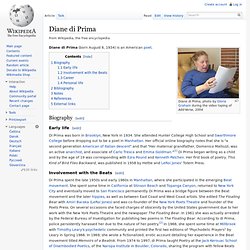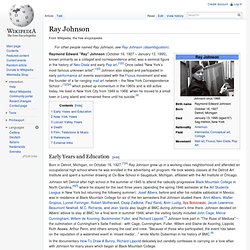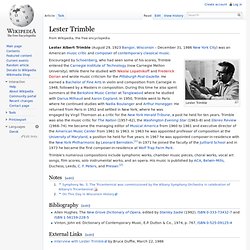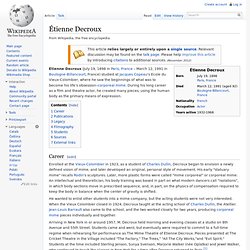

Diane di Prima. Diane di Prima, photo by Gloria Graham during the video taping of Add-Verse, 2004 Diane di Prima (born August 6, 1934) is an American poet.

Biography[edit] Early life[edit] Di Prima was born in Brooklyn, New York in 1934. She attended Hunter College High School and Swarthmore College before dropping out to be a poet in Manhattan. Involvement with the Beats[edit] Di Prima spent the late 1950s and early 1960s in Manhattan, where she participated in the emerging Beat movement. Career[edit] According to di Prima's official website, she also teaches workshops, with her most popular being one where she teaches attendees how to combine paintings or photographs with the printed word.
Ray Johnson. Raymond Edward "Ray" Johnson (October 16, 1927 – January 13, 1995), known primarily as a collagist and correspondence artist, was a seminal figure in the history of Neo-Dada and early Pop art.[1][2] Once called "New York's most famous unknown artist",[1][3] Johnson also staged and participated in early performance art events associated with the Fluxus movement and was the founder of a far-ranging mail art network – the New York Correspondence School –[1][2][4] which picked up momentum in the 1960s and is still active today.

He lived in New York City from 1949 to 1968, when he moved to a small town in Long island and remained there until his suicide.[4] Early Years and Education[edit] Born in Detroit, Michigan, on October 16, 1927,[1][4] Ray Johnson grew up in a working-class neighborhood and attended an occupational high school where he was enrolled in the advertising art program. New York Years[edit] I'm an artist and a, well, I shouldn't call myself a poet but other people have. Lester Trimble. Lester Albert Trimble (August 29, 1923 Bangor, Wisconsin – December 31, 1986 New York City) was an American music critic and composer of contemporary classical music.

Lester Trimble Encouraged by Schoenberg, who had seen some of his scores, Trimble entered the Carnegie Institute of Technology (now Carnegie Mellon University). While there he studied with Nikolai Lopatnikoff and Frederick Dorian and wrote music criticism for the Pittsburgh Post-Gazette. He earned a Bachelor of Fine Arts in violin and composition from Carnegie in 1948, followed by a Masters in composition. During this time he also spent summers at the Berkshire Music Center at Tanglewood where he studied with Darius Milhaud and Aaron Copland.
Étienne Decroux. Étienne Decroux (July 19, 1898 in Paris, France – March 12, 1991 in Boulogne-Billancourt, France) studied at Jacques Copeau's Ecole du Vieux-Colombier, where he saw the beginnings of what was to become his life's obsession–corporeal mime.

During his long career as a film and theatre actor, he created many pieces, using the human body as the primary means of expression. Career[edit] Enrolled at the Vieux-Colombier in 1923, as a student of Charles Dullin, Decroux began to envision a newly defined vision of mime, and later developed an original, personal style of movement. His early "statuary mime" recalls Rodin's sculptures. Later, more plastic forms were called "mime corporeal" or corporeal mime. He wanted to enlist other students into a mime company, but the acting students were not very interested. Arriving in New York in or around 1957, M. Returning from the United States to Paris in 1962, he opened his school in Boulogne-Billancourt where he taught almost until his death.
A. B. C. Jean-Louis Barrault. Amiri Baraka. Amiri Baraka (born Everett LeRoi Jones; October 7, 1934 – January 9, 2014), formerly known as LeRoi Jones and Imamu Amear Baraka,[1] was an African-American writer of poetry, drama, fiction, essays and music criticism.

He was the author of numerous books of poetry and taught at a number of universities, including the State University of New York at Buffalo and the State University of New York at Stony Brook. He received the PEN Open Book Award, formerly known as the Beyond Margins Award, in 2008 for Tales of the Out and the Gone.[4] Baraka's poetry and writing has attracted both extreme praise and condemnation. Carmine DeSapio. Carmine Gerard DeSapio (December 10, 1908 – July 27, 2004) was an American politician from New York City.

He was the last head of the Tammany Hall political machine to be able to dominate municipal politics. Life[edit] DeSapio was born in lower Manhattan. His father was an Italian immigrant, while his mother was of the second generation. He graduated from Fordham University in 1931. He started his career in the Tammany Hall organization as an errand boy and messenger for precinct captains. In 1949, DeSapio became the youngest Boss in the history of Tammany Hall, succeeding Hugo Rogers. Unlike many of the previous "bosses," however, DeSapio always made his decisions known to the public and promoted himself as a reformer. In 1953, he earned new respect and public admiration when he turned against the other Democratic leaders in New York City and used the power of Tammany Hall to help lead the defeat of highly unpopular incumbent mayor Vincent R.